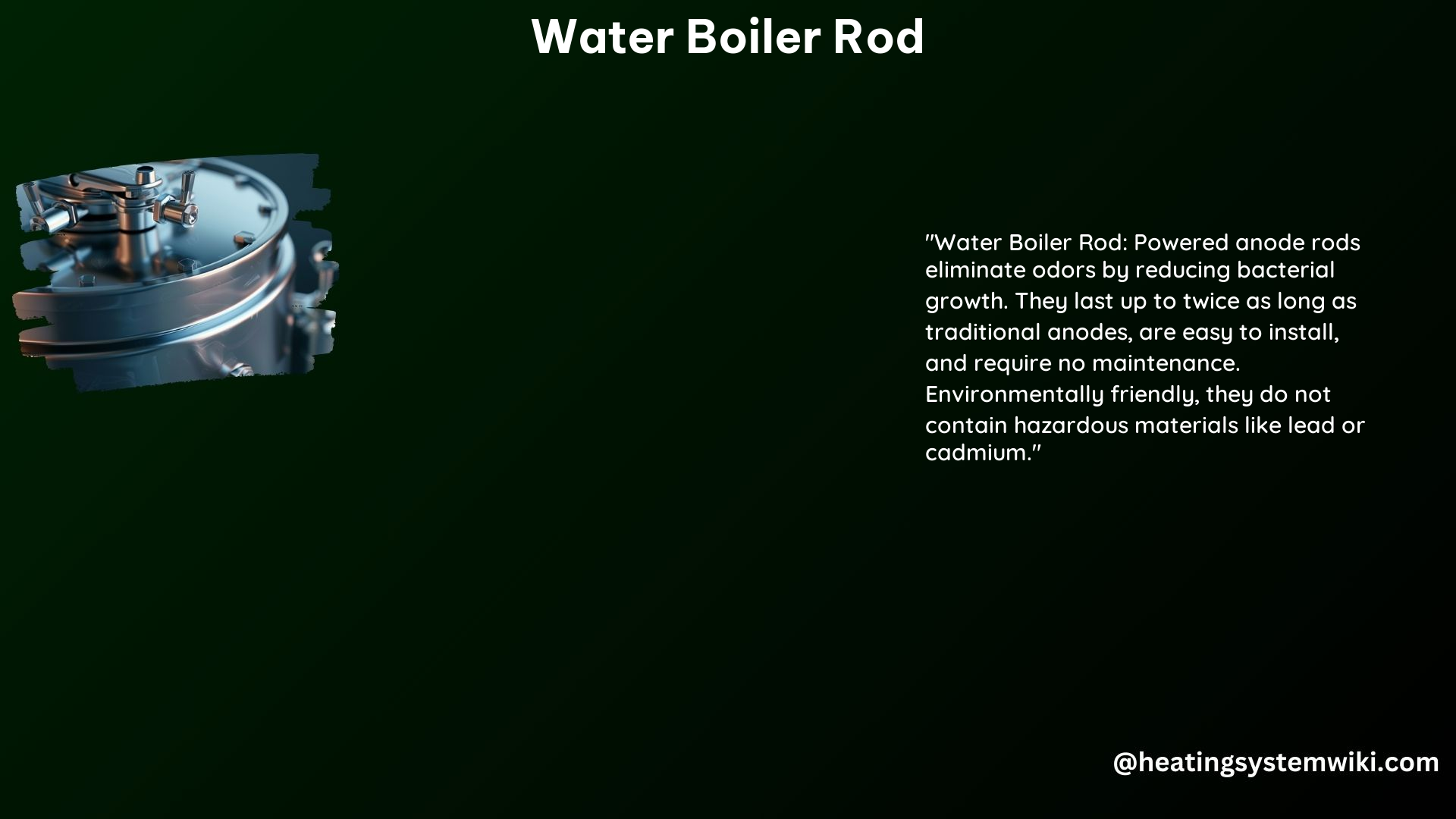Water Boiler Rods, also known as anode rods, are essential components in water heaters that play a crucial role in preventing corrosion and extending the lifespan of the appliance. These rods are designed to sacrifice themselves to protect the inner tank of the water heater, ensuring that your hot water supply remains reliable and efficient for years to come.
Types of Anode Rods: Choosing the Right One for Your Needs
When it comes to water boiler rods, there are three primary types to consider:
Magnesium Anode Rods
- Description: Magnesium anode rods are the most common type and are known for their high level of protection against corrosion.
- Usage: These rods are often used in residential water heaters and are relatively inexpensive.
- Dimensions: Magnesium anode rods typically range from 9 to 12 inches in length and have a 3/4″ NPT (National Pipe Taper) thread size.
- Lifespan: Magnesium anode rods should be replaced every 2 to 5 years, depending on water quality and usage.
Aluminum Anode Rods
- Description: Aluminum anode rods are less reactive than magnesium rods but still provide good protection against corrosion.
- Usage: These rods are commonly used in commercial water heaters.
- Dimensions: Aluminum anode rods typically range from 9 to 12 inches in length and have a 3/4″ NPT thread size.
- Lifespan: Aluminum anode rods can last up to 10 years, depending on water quality and usage.
Powered Anode Rods
- Description: Powered anode rods are powered by electricity and generate a steady stream of ions to prevent corrosion. They are known for their longer lifespan and ability to eliminate odors caused by bacterial growth.
- Power Requirements: Powered anode rods typically require a low voltage (e.g., 12V) and a moderate current draw (e.g., 9 amps).
- Dimensions: Powered anode rods come in various lengths, ranging from 9 to 15 inches, and have a 3/4″ NPT thread size.
- Lifespan: Powered anode rods can last up to twice as long as traditional anode rods, depending on usage and water quality.
Replacement Frequency: Maintaining Your Water Boiler’s Health

The frequency of replacing an anode rod depends on several factors, including water quality, usage, and the type of rod installed. Here’s a general guideline:
| Anode Rod Type | Replacement Frequency |
|---|---|
| Magnesium | Every 2-5 years |
| Aluminum | Up to 10 years |
| Powered | Up to 10-20 years |
It’s important to regularly inspect your anode rod and replace it when necessary to ensure the longevity of your water heater. Neglecting to replace the anode rod can lead to accelerated corrosion and eventual tank failure, which can be a costly and inconvenient problem.
Technical Specifications: Understanding the Details
When selecting a replacement anode rod, it’s essential to consider the following technical specifications:
Dimensions
- Length: Anode rods typically come in lengths ranging from 9 to 15 inches, with the most common being 9.25 inches.
- Thread Size: The standard thread size for anode rods is 3/4″ NPT (National Pipe Taper).
Material
- Magnesium: Magnesium is the most common material used for anode rods due to its high reactivity and ability to protect against corrosion.
- Aluminum: Aluminum anode rods are less reactive than magnesium but still provide good corrosion protection.
- Stainless Steel: Stainless steel anode rods are less reactive than magnesium or aluminum but can be used in certain water conditions.
Power Requirements (for Powered Anode Rods)
- Voltage: Powered anode rods typically require a low voltage, such as 12V, to operate.
- Current Draw: The current draw for powered anode rods is usually moderate, around 9 amps.
Understanding these technical specifications will help you select the right replacement anode rod for your water heater, ensuring optimal performance and longevity.
DIY Installation: A Step-by-Step Guide
Replacing an anode rod is a relatively straightforward process that can be easily done by a DIY enthusiast. Here’s a step-by-step guide to help you through the process:
-
Turn off the Power: Ensure that the power to the water heater is turned off and the circuit breaker is switched to the “off” position.
-
Drain the Tank: Partially drain the water heater tank to access the anode rod. This can be done by connecting a garden hose to the drain valve at the bottom of the tank and draining the water into a bucket or outside.
-
Remove the Old Rod: Use a wrench to loosen and remove the old anode rod. Be careful, as the rod may be corroded and difficult to remove.
-
Install the New Rod: Carefully insert the new anode rod and tighten it securely using the wrench. Make sure the rod is installed straight and tight to prevent any leaks.
-
Reassemble and Test: Once the new anode rod is in place, reassemble the water heater and turn the power back on. Check for any leaks and ensure the water heater is functioning properly.
Remember to dispose of the old anode rod properly, as it may contain hazardous materials. By following these steps, you can easily replace your water boiler rod and extend the life of your water heater.
Conclusion
Water Boiler Rods, or anode rods, are essential components in water heaters that play a crucial role in preventing corrosion and ensuring the longevity of the appliance. By understanding the different types of anode rods, their replacement frequency, and the technical specifications, you can make an informed decision when it comes to maintaining your water heater.
With the step-by-step DIY installation guide, you can easily replace the anode rod yourself, saving time and money. Remember to regularly inspect and replace the anode rod as needed to keep your water heater in top condition and enjoy a reliable hot water supply for years to come.
References:
- https://www.walmart.com/c/kp/electric-water-heater-rod
- https://rinsekit.com/products/hot-rod-water-heater
- https://www.homedepot.com/b/Plumbing-Water-Heaters-Water-Heater-Parts-Water-Heater-Anode-Rods/N-5yc1vZ2fkp6bw
- https://www.anodefactory.com/collections/powered-anodes-rods
